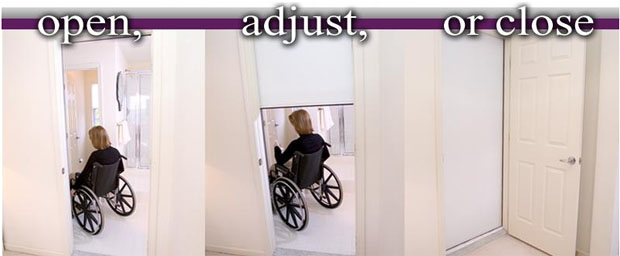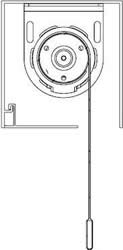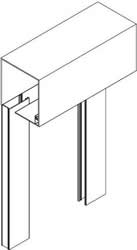One of the biggest hurdles facing a homeowner who, is modifying his home for wheelchair accessibility are the internal doors that separate rooms from hallways and adjacent occupied space.
Rationally, accessible doorways need to have a clear width of 36 inches and while this in itself can create challenges, creating enough space for a 36 inch door to open and close without hitting walls and cabinetry and other objects can be a daunting task.
Internal doors are hung in order to provide privacy. Internal doors, in most cases are not intended for security. With this in mind, there is an alternative to hanging the standard style of 36 inch privacy door.
Consider the installation of an electrically operated window blind, which we will now call an electric door blind, as the replacement for the standard privacy door, as shown in Figure 1.

Figure 1 - Accessible electric door blind
Electrically operated door blinds have been available for many years and are quite reliable. They have numerous features and benefits that make them a true alternative to standard privacy doors.
Note: If you are considering the installation of an electrically operated window blind as a door, do not expect to find them as electrically operated door blinds
. Under that terminology you will find blinds that mount on glass doors. You will have to search for electric window blinds.
There are a host of materials, colors and patterns available that provide a blackout effect, thereby ensuring visual privacy.
Note: Door blinds will not provide the same level of audio privacy as a standard hinged door.
Door blinds can also be installed as a secondary door. In other words, the solid door can remain in place and fully functional, as shown in Figure 1 – picture on the far right, with the door blind on the inside of the room.
Note: Most standard doors open into the room and if you are adding a door blind it may be necessary to hang the door so that it opens to the outside of the room rather than the inside of the room.
Door blinds move up and down rather than swinging on a set of hinges. Hence they require very little installation space. Most electric blinds fit in a metal valance above the door. The size of the valance is usually about 5 x 5 inches, as shown in Figure 2.

Figure 2 - Accessible electric door blind valance
Door blinds can be controlled by handheld remote controls and/or by keypads located on either side of the doorway.
The sides of the door blind, now your accessible door, slide in a narrow U
shaped track, as shown in Figure 3 which prevents them from moving due to changes in air flow and air pressure, such as opening an external door or window, within the home.

Figure 3 - Accessible electric door blind side channels
Most electric door blinds have the option of low voltage or regular 120VAC power.
Considerations:
- It should be noted that electric door blinds require power to open and close. In the event of a power failure the window blind will not operate. In order to prevent someone from being trapped inside a room, if a power failure occurs, it is highly recommended that you power the window blind from a UPS (uninterruptable power supply
), as shown in Figure 4, in order to allow the occupants to operate the electric door blind in the event of a power failure.
- Door blinds do not provide security. Applying a reasonable amount of force against the center of a door blind in its closed position will most likely release it from its side rails. This would allow someone in a wheelchair to exit the room in the event of a power failure, should a UPS not be installed.

Figure 4 - Uninterruptable power supply (UPS)
- Consideration can also be given to replacing standard hinged doors with vertical blinds. Vertical blinds can also be purchased motorized. In most cases vertical blinds do not provide the same level of privacy as solid cloth vertical blinds. However, between rooms such as kitchens and dining rooms, there may not be a need for
true
privacy, but more of a means of removing convenient visual access to another area. - Check with your local building department to ensure that the installation of an electric door blind does not infringe on any of their building codes.

